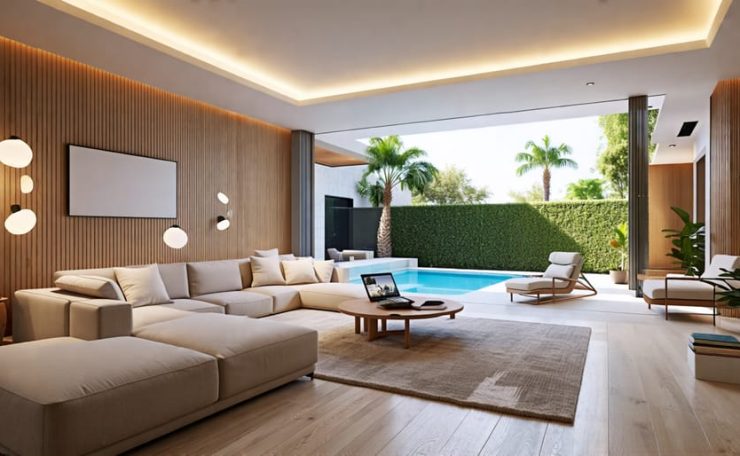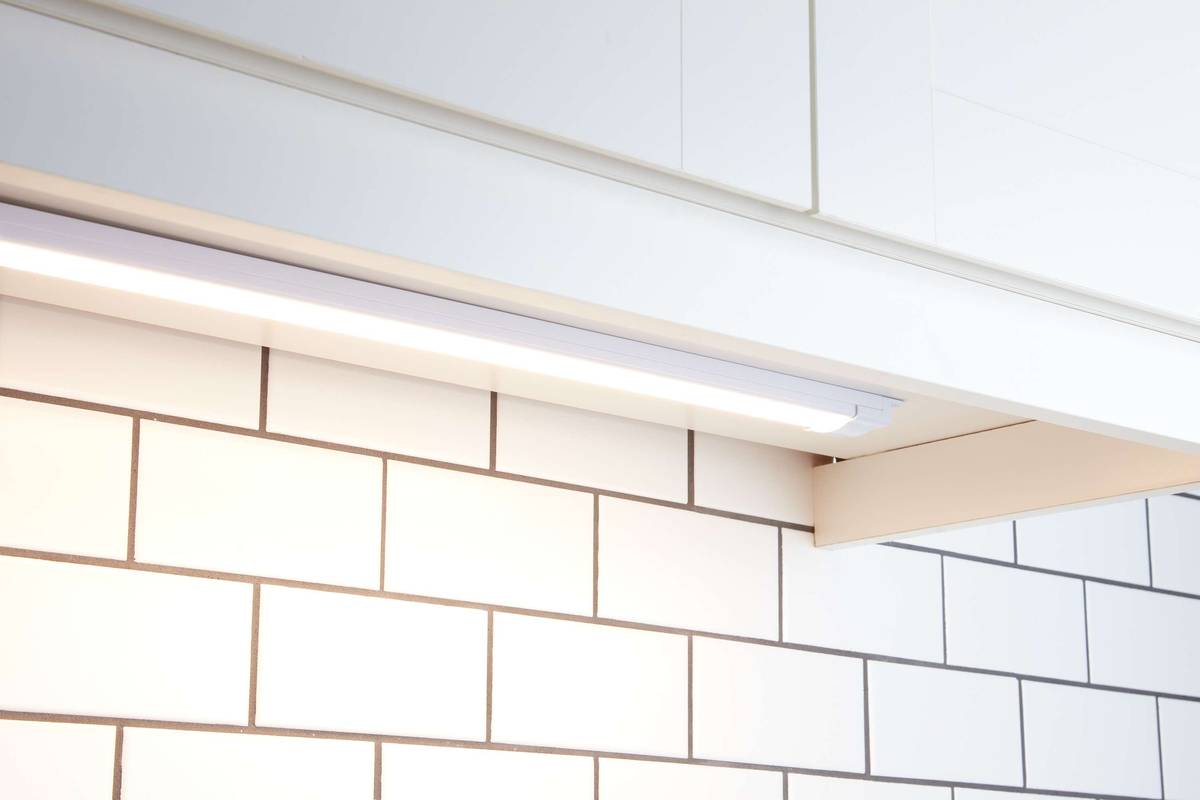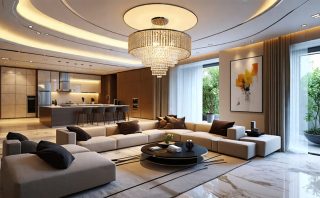Incorporate smart lighting solutions to enhance both efficiency and ambiance in your spaces, leveraging technologies like voice control and automated scheduling for seamless integration. Choose sustainable options such as LED fixtures and solar-powered lights to reduce energy consumption and environmental impact, aligning with green building standards. Opt for mood lighting to create versatile atmospheres, using dimmable lights and color-changing bulbs to adapt settings for relaxation or productivity as needed. Prioritize design-focused fixtures that serve as statement pieces, ensuring they complement the architectural style and elevate the overall aesthetic appeal of your environments.
Smart Lighting Innovations
Integration with Smart Home Systems
As we look forward to 2024, the integration of lighting with smart home technology takes center stage, revolutionizing the way homeowners personalize their lighting experience. The seamless connectivity offered by smart home systems allows lighting to dynamically adjust based on time of day, mood, or activity, creating a tailored ambiance in any space. By pairing advanced technologies like Bluetooth and Wi-Fi with Smart Lighting fixtures, users can effortlessly control brightness, color, and patterns via apps or voice commands. This innovation not only enhances convenience but also promotes energy efficiency by optimizing light usage throughout the day. Whether for a cozy evening at home or setting the mood for a business event, smart lighting solutions offer endless possibilities for customization, making them essential for both residential and commercial design. Stay ahead of the curve by integrating these cutting-edge solutions into your projects, enhancing both functionality and style.
Voice and App-Controlled Lighting
In 2024, lighting technology continues to evolve with a focus on seamless integration and user-centric design, making voice and app-controlled lighting a standout trend. By leveraging voice commands or mobile apps, users can adjust lighting settings from anywhere, ensuring convenience and personalization in various settings. Imagine altering your lighting to match your mood during a dinner party or easily dimming lights in a commercial space for enhanced ambiance—all without needing a switch.
For homeowners and interior designers, these systems provide an opportunity to create dynamic environments that can be modified in real time. With smart systems, the ability to set schedules and light scenes offers energy efficiency and flexibility tailored to personal preferences. Architects and commercial business owners find value in integrating such systems for optimizing workspace lighting, improving productivity, and reducing energy costs. By embracing this technology, you’re not just adopting a trend but investing in an intelligent, adaptive lighting solution designed to enhance living and working environments.
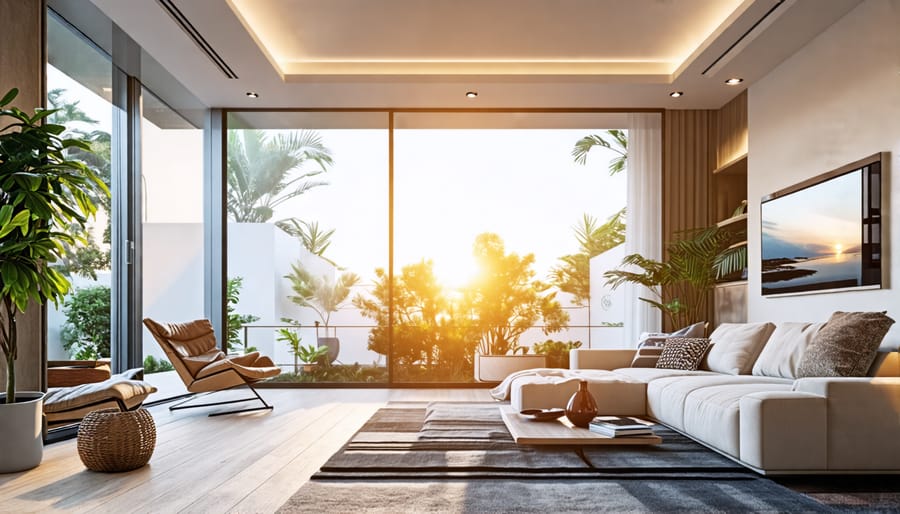
Sustainable and Eco-Friendly Lighting Choices
LED and Energy-Saving Innovations
In 2024, the evolution of LED and energy-saving lighting technologies is set to revolutionize both residential and commercial spaces. LED lighting continues to dominate due to its longevity, efficiency, and versatility. These lights not only reduce energy consumption but also provide a broad spectrum of colors and brightness levels, ideal for customizing settings according to individual needs and moods. Innovations like smart LEDs now integrate seamlessly with home and office automation systems, allowing intuitive control and scheduling, which further enhances energy savings. Additionally, advancements in organic LEDs (OLEDs) offer even more design flexibility, paving the way for ultra-thin, bendable lighting solutions. As energy efficiency becomes a higher priority across industries, embracing these technologies can lead to significant cost savings while promoting sustainability in design.
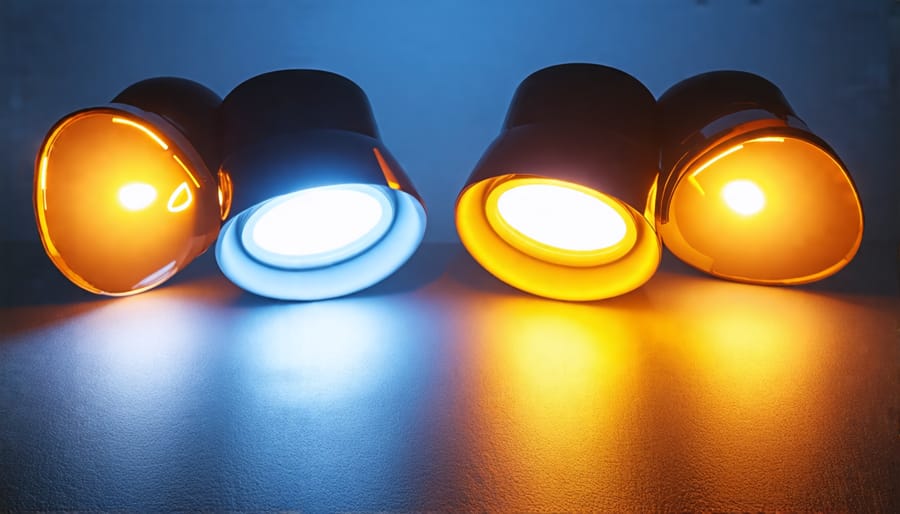
Recycled and Renewable Materials
In 2024, lighting design embraces recycled and renewable materials, offering eco-conscious solutions that appeal to both aesthetics and sustainability. Many designers are turning to recycled glass, bamboo, and repurposed metals to create eye-catching fixtures that reduce environmental impact while maintaining high-quality craftsmanship. These innovative materials contribute to a trend of eco-friendly elegance, catering to both residential and commercial spaces. Bamboo, known for its rapid growth and renewability, features prominently in pendant lights and lampshades, celebrating natural beauty. Recycled metals are crafted into sleek, contemporary designs, highlighting their versatility and enduring appeal. These sustainable materials not only enhance interiors but also resonate with a growing clientele committed to green choices, making them a sought-after component in modern lighting design.
Color and Ambiance: The Art of Mood Lighting
Dynamic and Adaptive Lighting Systems
In 2024, dynamic and adaptive lighting systems are taking center stage in both residential and commercial environments, revolutionizing the way we interact with our spaces. These advanced systems automatically adjust lighting conditions based on time of day, activity in the room, or even external weather conditions, providing a tailored ambience that aligns with users’ needs and preferences. Whether it’s a soothing, warm light for evening relaxation or energizing, cool hues for productivity during the day, adaptive lighting ensures the perfect setting for any occasion.
Key among these innovations are ‘smart’ lighting solutions, enabling seamless integration with home automation systems. These technologies offer personalized consultation opportunities, allowing homeowners and businesses to fine-tune their lighting preferences with ease. For architects and interior designers, this means an expanded palette for creativity, where light becomes as much a part of design as color and texture. Event planners can benefit from dynamic lighting, enhancing the atmosphere and guest experience with minimal effort. As lighting technology continues to evolve, those seeking modern and flexible solutions will find dynamic and adaptive systems a cornerstone of 2024’s lighting trends.
Role of Lighting in Wellness and Mood
Lighting plays a crucial role in enhancing wellness and mood in residential settings. As we move into 2024, the focus on using lighting to create healthier and more comforting home environments is gaining momentum. The right lighting can significantly influence mood; soft, warm lights are often associated with relaxation, aiding in stress reduction and promoting a tranquil atmosphere. Conversely, bright, cool lighting can invigorate and increase alertness, ideal for workspaces or morning routines.
Incorporating tunable lighting solutions allows for adjusting light intensity and color temperature according to the time of day or activity, promoting better sleep patterns and overall well-being. Smart lighting systems offer personalized control and flexibility, enabling homeowners to mimic natural light cycles, enhancing circadian rhythms. For homeowners and interior designers, understanding and leveraging these lighting dynamics is essential when creating spaces that support mental and emotional health. As 2024 trends embrace this connection between light and well-being, selecting the appropriate lighting solutions becomes an integral part of home design strategy.
Statement Fixtures and Design Elements
Chandeliers and Pendants as Art
Chandeliers and pendant lights in 2024 are more than just light fixtures; they are expressions of art and personality. Offering a blend of form and function, these pieces can transform any space with their sculptural beauty and innovative designs. As a homeowner or designer, opting for a statement chandelier unites aesthetics with practicality, creating a focal point that enhances the room’s ambiance. Modern designs feature a variety of materials—think of glass, metal, or recycled components—reflecting a commitment to sustainability while maintaining elegance. Whether you’re aiming for minimalism with geometric shapes or adding a touch of opulence with intricate designs, these fixtures can be tailored to fit any style or space, providing ample opportunity for personalization and creative expression.
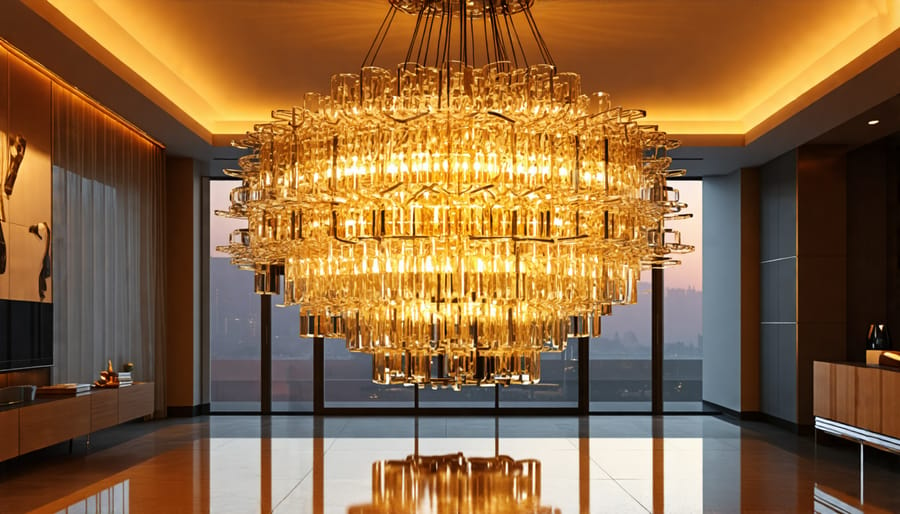
Industrial and Minimalist Influences
In 2024, industrial and minimalist designs are making a significant impact on lighting trends, merging functionality with aesthetic simplicity. Perfect for both residential and commercial spaces, these styles emphasize clean lines, raw materials, and muted color palettes, transforming spaces with their understated elegance. Industrial fixtures often feature exposed bulbs, metals, and matte finishes, adding an authentic, rugged charm ideal for creating focused environments. Meanwhile, minimalist lighting thrives on simplicity and geometry, using reduced forms to provide versatile, efficient solutions. Such fixtures may include slim, linear LED designs or geometric pendants that offer subtle yet effective illumination. These trends cater to homeowners and designers alike, providing a balanced approach that blends artistic design with practicality, suitable for various applications ranging from cozy living rooms to dynamic office spaces.
Conclusion
As we look ahead to 2024, the lighting design trends that stand out are those embracing innovation, sustainability, and aesthetics. The ongoing integration of smart technology continues to redefine lighting, allowing for enhanced control and personalization, perfect for both residential and commercial spaces. Sustainable lighting solutions are gaining prominence, with energy-efficient fixtures and eco-friendly materials increasingly in demand, aligning with the global shift towards environmental consciousness. Mood lighting, with its ability to transform spaces and influence ambiance, is becoming a staple in design, offering versatility for home and event settings. Finally, design-focused fixtures that serve as both functional and artistic elements are growing in popularity, catering to those who seek unique and customised solutions. For homeowners and businesses alike, these trends not only enhance the visual appeal but also contribute to energy savings and improved functionality, setting the stage for a bright future in design innovation.

